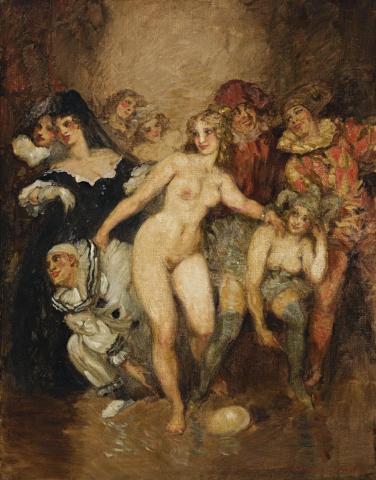PIERROT AND HARLEQUIN, c.1928
Norman Lindsay
oil on canvas
66.0 x 51.0 cm
signed lower right: NORMAN LINDSAY
handwritten label attached verso: Jane Glad / ‘Pierrot and Harlequin’ / signed LR / circa 1928
The Estate of the artist, New South Wales
Thence by descent
Private collection, Sydney
Characters of the theatre often found their way onto Norman Lindsay's canvasses, Pierrot and Harlequin being two of his favourites. This is not surprising for they had long attracted European painters. Jean- Antoine Watteau's Pierrot, c.1718-19, is in the Louvre, and both figures sport frequently in the art of Pablo Picasso, reflecting their even greater popularity in Italian and French theatre. Pierrot, the buffoon figure of mime and the Commedia dell'Arte, was traditionally dressed in a loose white costume with large buttons as fitting the character of the sad clown. He was hopelessly in love with Columbine. When she leaves him for Harlequin, another stock character of the Commedia Dell'Arte, she breaks his heart. Harlequin, the acrobatic trickster, in contrast is distinguished by his colourful, diamond-patterned costume. Both appear to left and right of Lindsay's central image of feminine beauty and desire. Other exotic costuming, lighting and frolicking good fun suggest a moment of theatre. Even the pale and melancholic Pierrot, so often the butt of others pranks, is involved through physical support and presentation by gesture of the main character - a Venus love goddess of Lindsay's invention and admiration. At her feet there lies a large egg, long a symbol for arcane beliefs to do with creation, spring and fertility. In Christianity it is the symbol of the Resurrection. Perhaps the artist had another kind of freedom in mind?
Ever the enemy of dogma, even traditional dress underwent various changes, as in Columbine, a 1918 drypoint and soft ground etching, and the 1929 watercolour Harlequin, 1929. In another etching, (Pierrot Conquered), c.1920, the colourful is preferred to the neutral black and white.
In Lindsay's unrelenting attacks on wowserism, the nude female figure was something to be admired in all its voluptuous beauty. That Pierrot can be changed from the perpetual lovesick sad sack to a smiling participant is proof of Lindsay's belief. Besides, each is a colourful character, destined to appeal to Lindsay's mind and temperament. Perhaps Lindsay had an even closer identification in mind. Harlequin, with his ability to transform through the touch of his magic wand, symbolized artistic creativity. Moreover, Harlequin, like Lindsay, lived outside society and its adopted norms and bourgeois morals.
DAVID THOMAS
